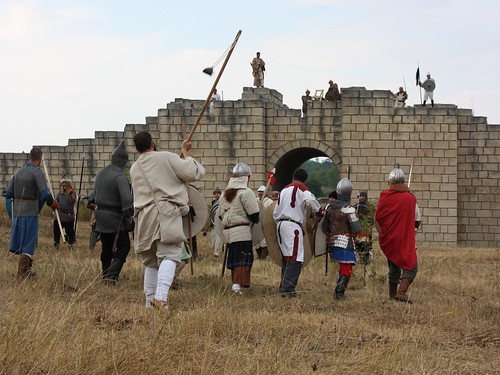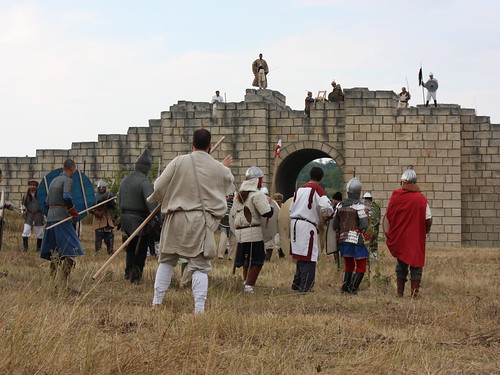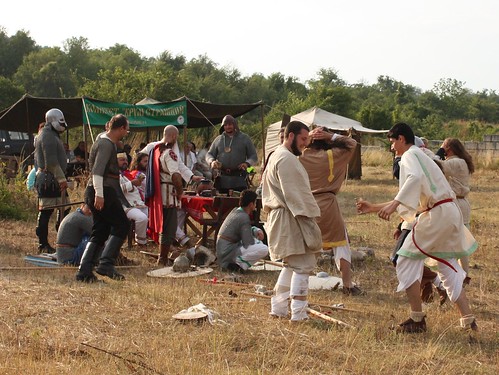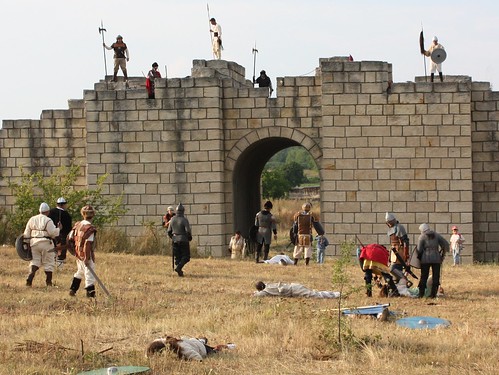
Η μάχη της Πλίσκα είναι στην πραγματικότητα μια σειρά από μάχες μεταξύ του Βουλγαρικού και του Βυζαντινού στρατού. Το 811 ο τότε αυτοκράτορας του Βυζαντίου Νικηφόρος ο Α', οργάνωσε μια μεγάλη εκστρατεία εναντίων των Βουλγάρων. Ο Βυζαντινός στρατός ξεκίνησε τον Μάιο από την Κωνσταντινούπολη με επικεφαλείς τον ίδιο τον αυτοκράτορα Νικηφόρο και τον γιο του Σταυράκιο. Μέσα στο καλοκαίρι έφτασε στην πρωτεύουσα Плиска (Πλίσκα - πρώτη αρχαία πρωτεύουσα της Βουλγαρίας) την οποία λεηλάτησε και κατέκαψε. Μάλιστα, οι χρονογράφοι της εποχής έκαναν αναφορές για διάφορες βαρβαρότητες των Βυζαντινών... Ο Βούλγαρος βασιλιάς (Χαν) Крум (Κρουμ - Κρούμμος) είχε καταφύγει στα βουνά και οργάνωσε ενέδρα στα στενά του Αίμου. Στις 26 Ιουλίου του 811, κατά την επιστροφή του στην Κωνσταντινούπολη, ο Βυζαντινός στρατός αιφνιδιάζεται από τον Κρούμμο στα στενά της Върбишкия (Βαρμπίσκια) και υφίσταται τεράστιες απώλειες. Ο Νικηφόρος σκοτώνεται στην μάχη ενώ ο γιος του Σταυράκιος διαφεύγει πληγωμένος σοβαρά και τελικά πεθαίνει από μόλυνση περίπου έναν χρόνο μετά... Λέγεται ότι ο Κρούμμος βρήκε το πτώμα του Νικηφόρου, το αποκεφάλισε, επαργύρωσε το κρανίο και το χρησιμοποιούσε ως κύπελλο για κρασί...
Στην Велики Преслав (Βέλικι Πρεσλάβ), κοντά στα ερείπια της Преслав (Πρεσλάβ), της δεύτερης αρχαίας πρωτεύουσας της Βουλγαρίας, κάθε χρόνο στις 26 Ιουλίου, γίνεται ένα είδος αναπαράστασης της μάχης από πολιτιστικούς συλλόγους της περιοχής...
Στην Велики Преслав (Βέλικι Πρεσλάβ), κοντά στα ερείπια της Преслав (Πρεσλάβ), της δεύτερης αρχαίας πρωτεύουσας της Βουλγαρίας, κάθε χρόνο στις 26 Ιουλίου, γίνεται ένα είδος αναπαράστασης της μάχης από πολιτιστικούς συλλόγους της περιοχής...


Στιγμές πριν από την "μάχη" / Moments before the "battle"....



Η μάχη αρχίζει... Ο Βυζαντινός στρατός εισβάλλει στην Βουλγαρική πρωτεύουσα Πλίσκα / The battle begins... The Byzantine army invades the Bulgarian capital Pliska...

Ο Βυζαντινός αυτοκράτορας Νικηφόρος ο Α' και ο γιος του Σταυράκιος εισέρχονται στην Πλίσκα / The Byzantine emperor Nikephoros I and his son Staurakios enter Pliska...

Ο Βυζαντινός στρατός έχοντας λεηλατήσει την Πλίσκα επιστρέφει στην Κωνσταντινούπολη. Την νύχτα στρατοπεδεύουν, τρώνε, πίνουν και διασκεδάζουν... / The Byzantine army, after plundering Pliska, returns to Constantinople... While going back, they settle a camp for the night and they eat and drink...

...αλλά ο Κρούμμος τους έχει στήσει παγίδα... Μια ξαφνική επίθεση μέσα στην νύχτα καταστρέφει σχεδόν ολοσχερώς τον Βυζαντινό στρατό... Ο Νικηφόρος σκοτώνεται στην μάχη και ο Κρούμμος φτιάχνει με το κρανίο του κύπελλο για κρασί... / ...but Khan Krum took them by surprise: An attack during the night destroys almost completely the Byzantine army. Nikephoros dies during the batlle and later Krum makes from his skull a drinking-cup.
[ENG] The Battle of Pliska was a series of battles between troops, gathered from all parts of the Byzantine Empire, led by the Emperor Nikephoros I, and Bulgaria, governed by Khan Krum. The Byzantines plundered and burned the ancient Bulgarian capital Pliska which gave time for the Bulgars to block passes in the Balkan Mountains that served as exits out of Bulgaria. The final battle took place on 26th July 811, in some of the passes in the eastern part of the Balkan, most probably the Vărbitsa Pass. There, the Bulgars used the tactics of ambush and surprise night attack to effectively trap and immobilize the Byzantine Army, thus annihilating almost the whole army, including the Emperor. After the battle, Krum encased Nikephoros' skull in silver, and used it as a cup for wine-drinking [English Wikipedia]. Every year, on 26 July 2006, at Preslav, the second ancient capital of Bulgaria, local cultural clumbs make a kind of representation of the battle...
[BUL] Битката при Върбишкия проход се състояла на 26 юли 811 между българските войски, водени от кан Крум и Византийската империя. [Уикипедия]









8 comments:
Great and breathtaking (especially landscapes) photographs. It's great that there's shorter English explanation which makes it easier to understand those beautiful pictures
Welcome to my blog, Sandradb and thank you for your comment!!
Έχουμε κι εμείς κάτι μαύρες σελίδες στην ιστορία μας...
Στην Βουλγαρία έχω ανακαλύψει πολλές... Καλημέρα Diastimata!!
Κάτι τέτοιες αναπαραστάσεις τις κάνουν κι εδώ, ενίοτε σε μεγάλη κλίμακα. Όσο για τις μαύρες σελίδες, σιγά που δεν θα είχαμε!
Τόσοι αιώνες ιστορία χωρίς μαύρες σελίδες γίνεται;
This is really nice blog, Klearchos. You show in deed how we must look at our common history: objectively, at all angles, without too much superlatives for one side, and negation for the other. Because each historical event (especially battles) has at least two sides. I would like to ask you if I could include a couple of photos in my knol (http://knol.google.com/k/людмил-антонов/battle-of-pliska/1bjs24sr0a59u/1), of course, with giving you a credit and providing a link to your blog. Or, maybe, invite you as an author of the knol, to give some more input on the Byzantine side of the story.
Thank you very much for your comment, Lyudmil! Of course you can use whichever photo you like!
Post a Comment